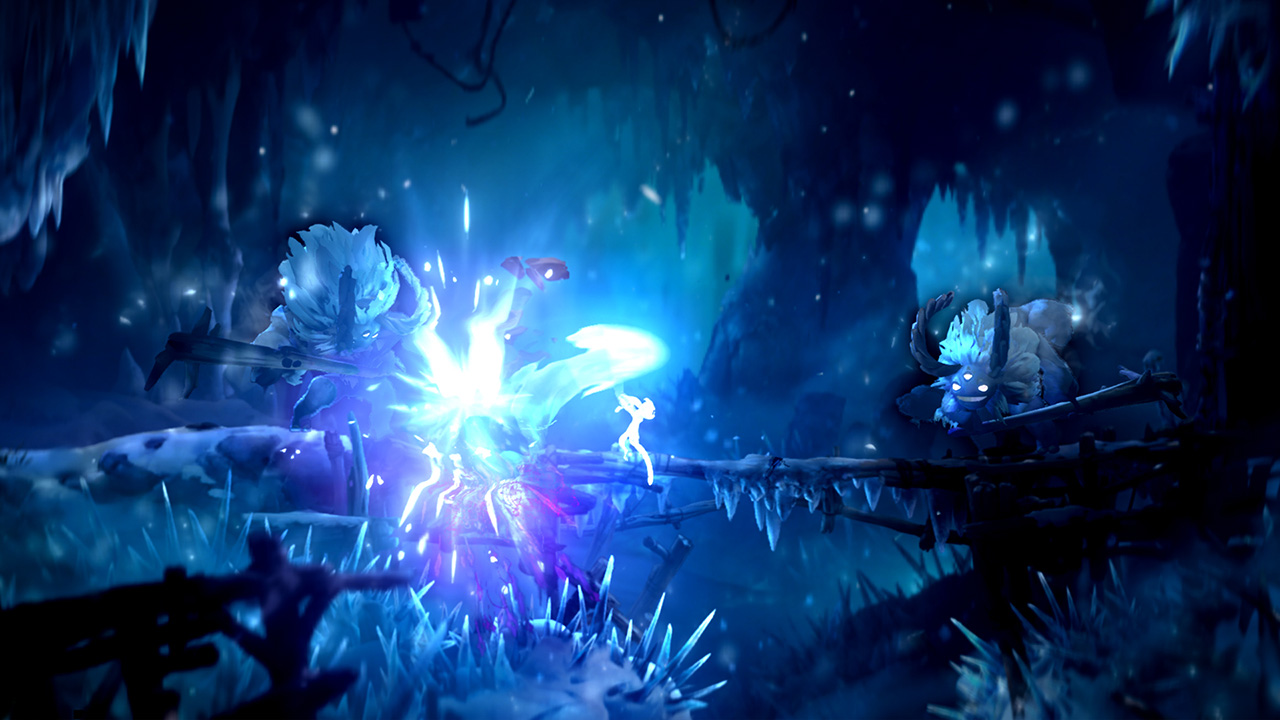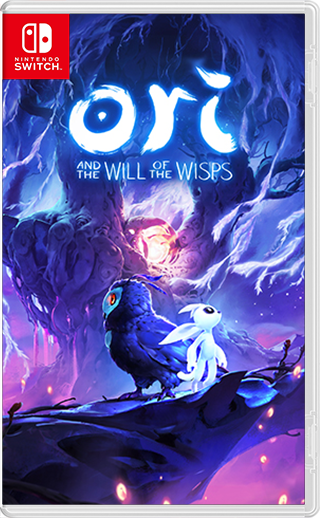“If it ain’t broke, don’t fix it.” So goes one of the most well-known aphorisms in the English language, and one that the developers at Moon Studios appear to have taken to heart, because their luscious follow-up to the beautiful Ori and the Blind Forest, a painterly Metroidvania with an ethereal atmosphere and an emotional story is… well, pretty much just that again.
Of course, that’s far from a bad thing. Will of the Wisps is just as gorgeous as its predecessor, with the same lush naturalistic environments rich in color and flora, visually distinct and rich with secrets. There’s a variety of new locales to explore, from frigid mountains to lush magenta bogs to a mouldy, spider-laden cave complex, and each has its own plethora of items and collectibles to find… even if the art direction is ultimately nigh-identical to the first game, considering how good the first game looked that’s far from a bad thing. The only nitpick is that the lower Switch resolution sometimes make the vivid art a bit pixelly and blurry – which hurts this game in particular considering how much of an appeal the art design is – but it’s a minor gripe in the face of the visual splendor.
A bigger and more nagging source of deja vu comes in the game’s narrative. The first Ori was a tearjerker about a sole spirit of light seeking to restore a land fallen to darkness and decay while avoiding the wrath of a demonic shadow owl. The sequel is… a tearjerker about that same spirit of light seeking to restore a different land fallen to darkness and decay while avoiding the wrath of another demonic shadow owl. While it’s not a complete 1:1 retread – the plot beats venture in slightly different directions, and the resolution swerves to be bittersweet rather than completely happy – it is a little strange just how similar the two games are conceptually, and makes the sequel feel somewhat stagnant as a result.

What is not as stagnant is the game’s combat, which is definitely the standout improvement. Two of Blind Forest’s biggest weaknesses were in its save system (which, due to relying on a finite resource that you also needed for other tasks, made it very easy to end up in sticky, untenable situations) and core combat (which consisted of homing attacks that felt slightly unwieldy to use). Both issues have been quashed entirely: saving is now automatic, freeing up your Energy Cells to use a variety of skills from healing to projectiles, and combat is now done with a more traditional slash-or-smash button setup that feels much more intuitive. Add in the ability to customize your loadout at any given time, and fighting enemies feels much more engaging and interesting this time around… even if most of the skills don’t feel particularly worthwhile (though I’m sure some will suit certain playstyles better than others).
The world of Ori still follows that of the traditional Metroidvania: start out with few abilities (or in this case, none – it takes maybe half an hour before you can even fight enemies consistently, which makes the opening really stand out) and slowly accrue more as you progress, opening up more of the map with your newfound exploration skills. Will of the Wisps gets one leg up on its predecessor by opening up a bit more in the second half of the game, offering you a choice between four different areas and what order you want to tackle them in, granting some extra replay value and ultimately creating a more substantial experience.

New to Will of the Wisps are sidequests and NPCs in general, populating the land of Niwen with characters for you to interact with and more activities for you to do. While none of the NPCs are overflowing with personality, it does make the world more lively and interesting to interact with, especially since their requests are almost wholly optional but always beneficial – whether it’s in providing currency to buy upgrades or collectibles to boost your stats or simply to notch up the completion percentage on the map screen. The first Ori was a pretty lean experience, and the sequel comparatively has a lot more meat on the bone – without becoming overbloated and fatty in the process.
But while these improvements are great, and the game is still a blast to play (I never once felt like it was a drag after a solid 13 hours), there was just a certain… magic missing. Or maybe it really is more accurate to just say that the magic feels the same the second time around. What made Blind Forest so fantastic was how invigorating and fresh it felt, how it managed to weave such beauty out of a distinct world of light and shadow… and its follow-up just feels like it’s going through the motions, evoking those same core images again without truly seeking to dazzle in a way that captures the same awe and wonder.

It leaves Will of the Wisps in a strange position – on the one hand, basically every element of the game is either equivalent to or superior to its predecessor, meaning that if I had to choose between playing one or the other, I’d take this one at every opportunity. But at the same time, the experience of playing Blind Forest for the first time was much more striking, leaving me with fonder memories of the first game despite the fact that I think it wasn’t as good. As a result, I’m tempted to score it lower despite the fact that it was better. Human brains are funky beasts…
In the end, of course, these are minor gripes, and Ori and the Will of the Wisps is well worth picking up regardless of who you are, and it’s certainly one of the best games to hit the Switch this year. If a third game in the franchise ever happens, I’ll be lining up at the door to experience it first thing. But I can’t shake the sense that this game could’ve been a little more ambitious, shot a little higher, strived for something more than it ended up being. Ori may have not needed any fixing, but the second time around, the machine doesn’t feel quite as lustrous.
Leave a Comment
System: Nintendo Switch
Release Date: September 17, 2020
Categories: Action, Platformer
Publisher: iam8bit
Developer: Moon Studios GmbH


